#1980's manga
Text
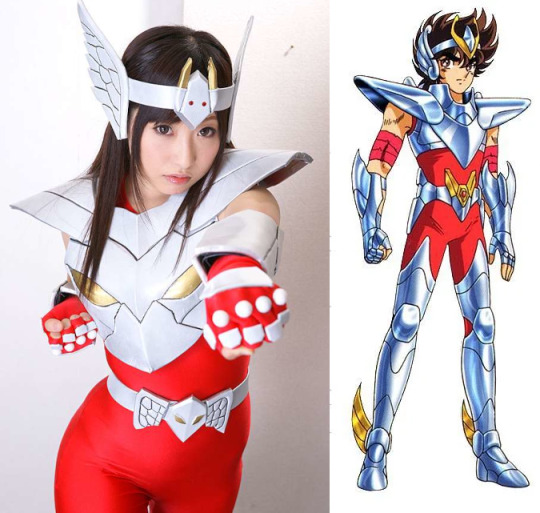
Gender-flipped Pegasus Seiya from Saint Seiya (1985).
34 notes
·
View notes
Text

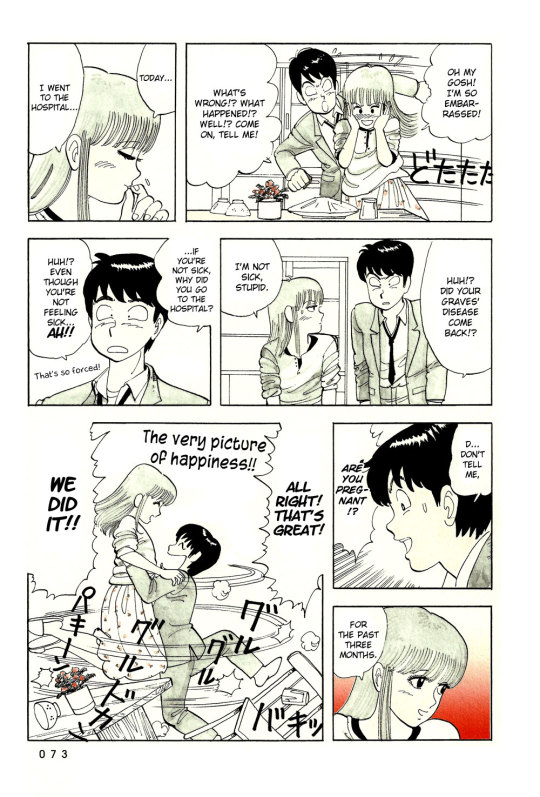
I knew it could be done.
#Stop!! Hibari-Kun!#Manga#ignore the fact that this was a dream sequence#if he believes hard enough he can impregnate her he just has to try over and over again#if you're unfamiliar with the manga hibari is about as explicitly trans as you can get for the 1980's
137 notes
·
View notes
Text
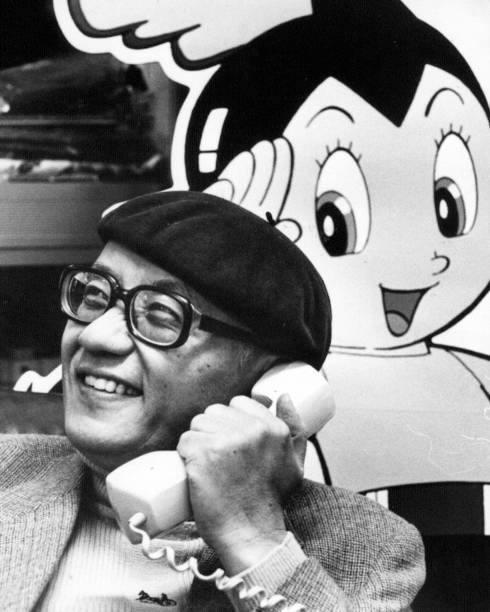
手塚 治虫 (1984年)
Osamu Tezuka (1984)
109 notes
·
View notes
Text

#Anime & Manga#1980's Anime and Manga#Akira Toriyama#Shonen#Dragonball: Broly Movie#2018 Movie#Broly#Saiya-jins#Mutant Saiya-jin#Son Goku/Kakarot#Son Goku#SSJB#Super Saiya-jin transformation#Sci-fi#Action and Adventure#Toei Animation
8 notes
·
View notes
Text

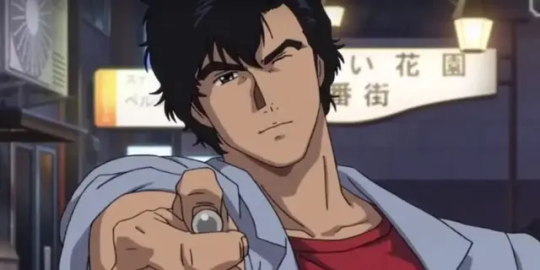

シティーハンター - 冴羽獠
リョウはシリーズの主人公です。 リョウは3歳のとき、中米での飛行機事故で唯一の生存者となった。 彼はゲリラ戦士として育てられ、自分の以前のアイデンティティについては知りません。 戦後、リョウはアメリカに渡り、その後東京に移り住む。
東京では槇村秀幸とともに「シティーハンター」チームを結成するが、秀幸の死後、香がリョウの新たなパートナーとなる。 非常に熟練したガンマンであるリョウは、標的のまったく同じ場所にすべての射撃を着弾させる「ワンホールショット」を実行することで知られています。 彼のお気に入りの武器はコルト パイソン .357 マグナムです。
リョウは同僚の伊集院隼人に「海坊主」というあだ名を発明し、彼はリョウに「新宿の種馬」(新宿の種馬)というあだ名を付けたと答えた(リョウは人を殴ろうとする真の変態だから、皮肉な名前だ) 彼は出会ったり見たりした美しい女性にすべてを言いますが、毎回失敗します)。 リョウはリボルバー、半自動銃、マシンピストル、ライフル、カービン銃、クロスボウを扱う熟練した射撃の名手です。 彼は白兵戦をよく知っており、必要なときには真の命知らずのように運転します。 彼の車はミニです。
4 notes
·
View notes
Photo

Dragon Ball title page
#dragon ball#dragonball#akira toriyama#manga#goku#bulma#yamcha#yamucha#oolong#puar#dragon ball z#80s#1980's#80's vibes#comics
47 notes
·
View notes
Text

X+Y, Hagio Moto (1984)
1 note
·
View note
Text
REVIEW: Five Star Stories #1 (1989)
REVIEW: Five Star Stories #1 (1989)
A manga by Mamoru Nagano
I have owned this apparently insanely rare manga volume for like twenty years, and for whatever reason, I have yet to ever read it. I re-discovered it in a stack of Dungeons and Dragons books I once bought on discount at my old job (like fifteen years ago!), and somehow this stayed sealed away. This is a shame because I love old manga, and especially old mecha-related…
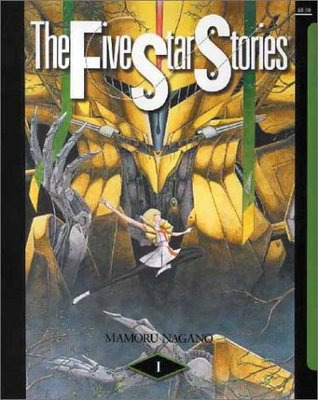
View On WordPress
0 notes
Text
Misunderstanding
I received a note from someone who was upset I “failed to cite Scott McCloud’s Understanding Comics” in my research for my work on Neil Gaiman's Chivalry and the essays I wrote about it.
I really appreciate that people want to make sure credit goes where it's due, and I have a lot of respect for Scott McCloud's accomplishment with his wonderful book.
I haven't read it myself in some years, and didn't cite it in my articles because I didn't reference it. I don't even know where my copy is so I don't know what McCloud referenced, either.
The information in my articles re: illuminated manuscripts and the Bayeux Tapestry, as well as other theories about the development of sequential art from prehistory, not only predate McCloud's work (and in fact, predate McCloud's birth,) but they are so common and so well known in comics circles that asking me to cite them seems as weird to me as asking me to cite the information that George Washington was the first President of the United States.
A part of me wonders if someone is trying to play, "Let's you and him fight."
No.
But I’m happy to bring to your attention some reading material.
Stephen Becker in his 1959 work Comic Art in America: A Social History of the Funnies, the Political Cartoons, Magazine Humor, Sporting Cartoons, and Animated Cartoons was among the first to discuss the Bayeux Tapestry as comic art. I read that book sometime in the 1980’s. I think a lot of people assume the Bayeux tapestry as comic art was McCloud’s idea, but we don’t all walk around with a reference library in our heads, so there you go. I can’t find my copy of Becker’s work to quote, but I did find an article by Arthur Asa Berger with a mention of the Bayeux Tapestry as comic art in the summer 1978 issue of The Wilson Quarterly.

My first exposure to the idea of comics as descendant of fine art was Maurice Horn’s 1976 The World Encyclopedia of Comics which was my first read re: comics history. I still have my tattered 1976 edition.
While Horn scorned the idea that tapestries and manuscripts could be comic art (see, it was a matter of discussion way back then, so much so that authors were writing snarky asides to one another about it,) he believed the origin of sequential art was in the Renaissance sketches of Leonardo da Vinci - which I think everyone now agrees is kind of a bonkers idea.

I think Horn was just intent on elevating the comic art form by hooking up with da Vinci.
You go, boi.
Comics as descendant of art on scrolls is a very common theory, the easiest to trace being in Manga! Manga! The World of Japanese Comics by Fred Schodt published in 1983 when I was still a teenager. I can't find my copy to show examples, but this text is still in print and you can go read it for yourself.
I was introduced to manga by cartoonist Leslie Sternbergh and bought Schodt’s book at Books Kinokuniya on (I think) a trip to New York around the time of first publication of Schodt’s work. And years later took a trip to Japan with Fred Schodt and a group of cartoonists including Jeff Smith and Jules Fieffer, Nicole Hollander, and Denys Cowan as the guests of Tezuka Productions.
Here we all are.

So, I’m familiar with manga, see.
As for comics as descendant of cave paintings, hieroglyphics and ancient art in general, Will Eisner’s 1985 Comics and Sequential Art not only made all of those points, but made those points with comic art examples. Like these.

And this.

And this.
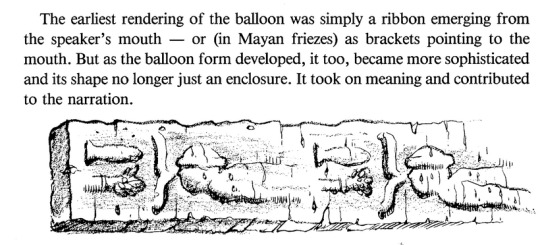
And more than a few words on this:


I find it amusing that someone is questioning why I didn’t cite McCloud when what you should probably be questioning is why more people don’t cite Eisner who produced his book eight years before McCloud published his and who is well known to have influenced McCloud.
Whatever. My book's autographed.
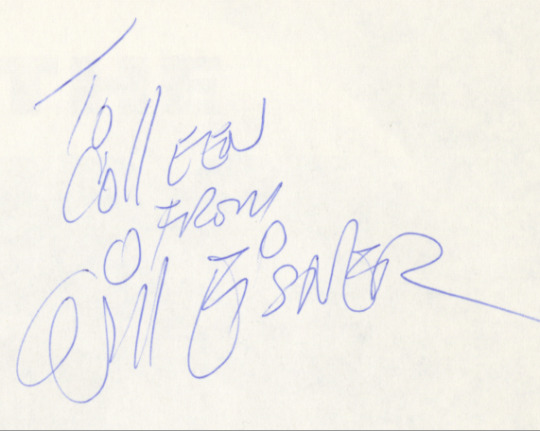
I also danced with Eisner. Eat your heart out.
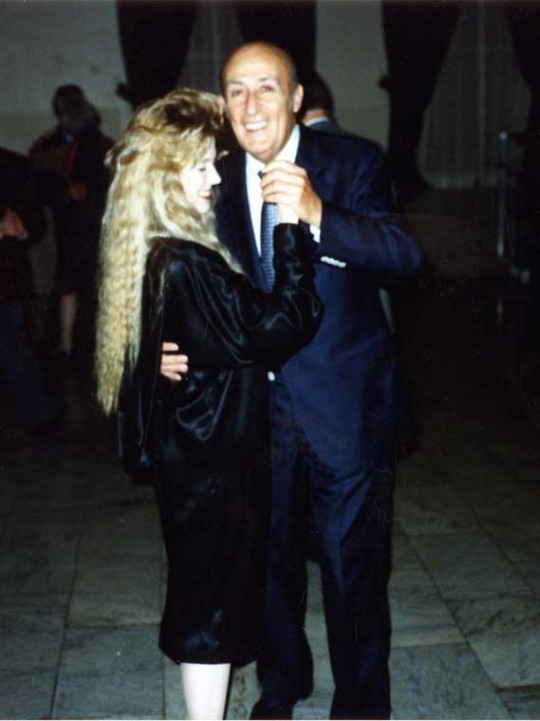
Understanding Comics is a terrific work with huge advantages over every book (that I know of) about comics that came before: it taught comics entirely in the language of comics.
But the discussion in it about the origins of comics and my work especially re: illuminated manuscripts/tapestries, did not originate with McCloud. I research illuminated manuscripts because it’s my hobby and it informs my art.
I encourage everyone to read Understanding Comics because it is an outstanding work.
But it’s not the book that introduced me to the concepts of the development of comic art. It’s not even the point of origin of those concepts. So, there is no reason to cite it.
Also, shocking as it may seem, I occasionally come up with ideas on my own. While I'm younger than McCloud, I've actually been a comics pro longer than he has. So I've had plenty of opportunity to, you know, read things and toss things around, and decide for myself.
When I first read Chivalry and first begged Neil Gaiman to let me adapt it, my head full of the work of Alberto Sangorski and his art for Tennyson’s Le Morte D’Arthur, Understanding Comics hadn’t been published yet.
It's been a good twelve years since I last read McCloud's work, and I don't think I've spoken to him five times in the last three decades. But I'm pretty sure he never mentioned Sangorski.
I hope that clears everything up, and maybe introduces some of you to some works you might not be aware of.
Have a great day.
#understanding comics#comics history#neil gaiman#scott mccloud#chivalry#jules fieffer#tezuka productions#manga#will eisner
2K notes
·
View notes
Text

Aaaaaand here's my second contribution for the @flash-exchange! and this was written for the darling @spoopy-fish-writes. I had the idea for this pretty early and I can't stop giggling at it, honestly.
Title: Mischief
Characters: Will/Fem!reader, Sebastian, Dazai
Prompt: Kabedon
Tags: fluff, kabedon, Dazai being a lil shit, Sebastian isn't helping
You had just finished making that evening's coffee with Sebastian, making light conversation with him. You reminisced about some things from your original time, lightly complaining that so many of the romance books you tried to read could use a little more… impact.
“Honestly, there are so many scenes that could be amplified with a kabedon, but that didn't even come about in our time until the 1980's,” you sighed. You were glad you hadn't picked up the whole tray as a voice from behind made you jump.
“Kabe-don?” Turning quickly you saw Dazai leaning in the doorway, a lazy smile on his face and a contrasting mischief in his eyes.
“Good evening, Dazai. Yes, a kabedon. She's referring to a moment in modern Japanese manga and animation in which one character essentially somewhat traps another character against a wall.” Sebastian moved to the wall and displayed the position. “Now, imagine there's another person between me and the wall with them facing me. My flat hand hits the wall beside the other person's head. Kabe for wall, don for the sound the impact makes. Usually there is romantic tension between the two characters.” You felt yourself blushing as Sebastian explained. You swore you saw a spark in Dazai's gaze as he acted unphased with the new information.
“I see. It dramatically raises tension between two characters. The sudden proximity, an air of dominance. Hm. Thanks for the tip.” He smiled coyly before leaving you and Sebastian in the kitchen. A heavy sigh left your lips and you pinched the bridge of your nose.
“Why do I have a bad feeling about this?”
-
The night was getting long and as much as you and Will loved to visit the mansion for dinner occasionally, you were both ready to go home. The interaction earlier with Dazai had all but left your mind as the two of you walked from the carriage stop back home. That was until you both reached the house and Will lingered instead of unlocking the door. You looked at him curiously.
“Will?” You prompted him softly with his name, his playful and heated gaze making you shiver.
“Apologies, dear heart. Mine mind hath wandered,” he grinned, pressing a kiss to your temple before proceeding to unlock the door. You knew him well enough to know there was something on his mind but there would be a time and place for bringing it up. Thankfully the wait was short because as soon as you were both inside…
*don*
Your back was suddenly against the wall, heart racing as you looked wide-eyed up at Will. Your stomach fluttered excitedly as he crowded your space. His hand had landed firmly on the wall by your head and his smirk made you blush. He couldn’t help but chuckle as your cheeks turned a brilliant shade of pink and he brought his hand up to caress one with his thumb. “My, my. Curiouser and curiouser,” he murmured.
“W-Will…” you stuttered softly, beginning to pout as the pieces slowly came together in your mind. “Did you speak with Dazai tonight by chance?” He laughed and leaned in closer, pressing a kiss to the tip of your nose.
“I know not of what you speak,” he grinned as your pout deepened. “Though… I suppose thanks is owed to him for this most… gratifying reaction. I’ll have to employ this guileful tactic more often, no?”
Taglist: @violettduchess , @strawberry-scum , @writingwhimsey , @ikememesengoku , @kissmetwicekissmedeadly , @jozhenji
#ikemen flash exchange#ikemen vampire#ikemen will#william shakespeare#ikemen dazai#ikemen sebastian#fluff#kabedon
41 notes
·
View notes
Text


DEFENDER, PROTECTOR, & WARRIOR OF THE FOREST -- PRINCESS OF THE WOLF GODS.
PIC(S) INFO: Spotlight on San, the "Wolf Girl Princess," from the 1997 Japanese animated feature film from Studio Ghibli, "Princess Mononoke," directed by Hayao Miyazaki. Artwork/colors by Jim Lee, c. summer 2018.
"Lee has spoken about his love for manga and anime in many public forums. He reportedly cited manga styles as an influence in his iconic "Punisher: War Journal" series in the 1980s, and in recent years he has said that his kids have drawn his attention back to the genre.
During panels, con appearances and podcasts, Lee has often mused about how his daughters are more interested in manga and anime than Western superheroes.
"My kids, they draw huge eyes on all their figures," he said, laughing at the Canadian National Comic Expo in 2006. "What's up with that? Why is everything backwards? You don't want to put color on it?"
-- COMIC BOOK (Michael Hein), c. August 2018
Source: https://comicbook.com/anime/news/dc-comics-jim-lee-princess-mononoke-sketch.
#Princess Mononoke 1997#Studio Ghibli#Wolf Princess#Hayao Miyazaki#Anime#Jim Lee#Fantasy Art#Jim Lee Artist#Jim Lee Art#San#サン#もののけ姫#Mononoke-hime#Wolf Girl Princess#Studio Ghibli Films#Studio Ghibli Movies#1997#Princess Mononoke 1997 Movie#Japanese Animation#Animation#1990s#San Princess of the Wolf Gods#Ghibli#San Princess Mononoke#Fantasy Movies#Princess of the Wolf Gods#Fantasy Films#Epic Historical Fantasy Films#Fantasy#Miyazaki Hayao
22 notes
·
View notes
Text
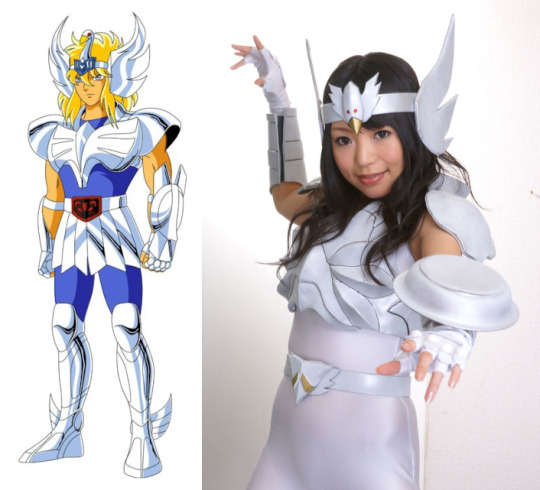
Gender flipped Cygnus Hyoga from Saint Seiya (1985).
15 notes
·
View notes
Text
So I thought it'd be silly and detract from this post to talk about fandom underneath it
But I've been looking for a way to talk about this and I think this is as good a start as any.
I keep seeing a lot of people confused as to why Kazui, assuming he is a gay/aro/other closet LGBT man would want to 'decieve' Hinako by lying to her about being in romantic love with her and marrying her
It makes sense, if you're young and from the right area, you might not know a lot of history, its certainly not taught in schools.
For example, to many people 'gay panic' is a cute trope, wherein a person struggles with their newly discovered identity and not a legal defence people used to excuse the beating and murder of gay people
Kazui is 39 years old. He would've turned 40 in August 2020, meaning he was born in 1980
When the comic above about Bert and Ernie getting a civil union (not even marraige yet) was made in 2003, he would've been 23.
By the time gay marraige was legalised in the US, it was 2015, Kazui would've been 35 (and despite Kazui being Japanese, because other countries like to copy America, the US legalising gay marraige was absolutely celebrated by LGBT people worldwide)


(here's a section of Our Dreams At Dusk a manga that began publication months before the legalisation of gay marraige in the US showing just two states legalising gay marraige as being news worthy to LGBT people in Japan)
The first Asian country to legalise gay marraige was Taiwan in 2019
Japan is expected to be the second... but they're taking their time
Gender identity and sexual orientation are also not nationally protected civil rights, meaning protection from discrimination depends on the prefecture you live in.
And this is without getting into darker subjects like higher self harm/suicide rates or violent crimes against LGBT people
I don't want to be doom and gloom, many people are becoming more aware and accepting of LGBT people. But Kazui had every reason to wish to remain closeted
For all people talk about a 'divorce stigma' I believe it is silly to have expected a gay man in the 2000's, when many people even in the states thought gay marraige was unattainable in their lifetime, to have considered that when he got married to someone in an attempt to conform to society
Especially because most difficulty to remarry after divorce comes from views surrounding custody laws and adoption. A lot of people don't want to get in a relationship with someone who already has children since they don't view them as their own on account of being blood related.
This is probably why Fuuta's mother left Fuuta and his sister with their father.
It's very notable that Milgram lampshades how by Kazui's age he was 'expected' to have children but didn't. We don't know Hinako's opinion on having children, but its possible Kazui intentionally didn't have any with her for this reason (despite feeling melancholy he could've had a child Muu's age by now)
Shidou had children (the eldest of which he likely sired while still being in medical school), Mahiru was still in university and thinking about planning a family, Amane notes that her mother gave birth to her when she was Mahiru's age. (TLs from Rochisama)
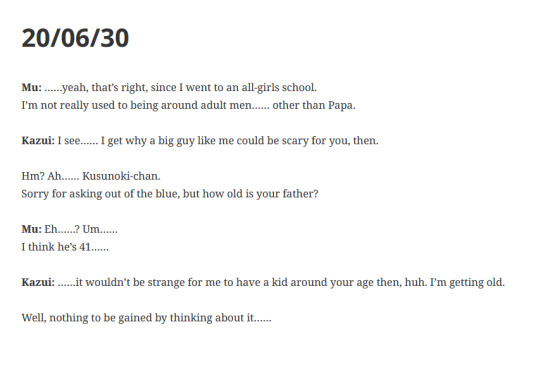


These aren't malicious feelings imo. This is Kazui noticing a coworker he likes is romantically interested in him and taking a chance on her in the hopes that playing a role as a straight man will make him into one. (unfortunately the suit doesn't fit)
There is a Japanese saying of 出る杭は打たれる 'the nail that sticks out gets hammered in' suggesting it is better to not stand out
(interestingly, the below lyric is the same in Japanese and English but in French its more like 'I can't take it anymore, I'm different')
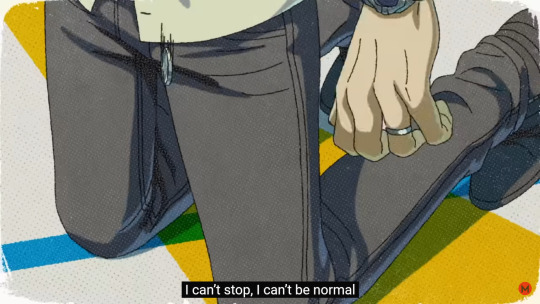
It's also worth noting that gay people getting into heterosexual relationships even outside of Japan, used to be Extremely Common. Like my mother has a co-worker who did it
In addition, Yokohama is one of the more expensive places to live in Japan. Mixed with his expensive looking wedding and the traditonal dress of the family at his wedding. It's very likely he comes from a wealthy (conservative) background which would contribute to pressures
I'm rambling a little, i'm quite tired. But I don't want people to think this means they Have to vote Kazui innocent. I don't know your theories. Maybe you think he's straight or sexuality is entirely irrelavent to his crime or you think he's gay but you just want to vote him guilty for some other reason.
Any reason is allowed (although non-milgram fans trying to use him as a luck shrine has to be pretty weird)
I just think that when you judge Kazui as a gay man who 'lied' to a straight woman, you need to look at the context it happened in and the many real people who still exist in marraiges like that.
Beware whomst you call deceptive or manipulative in a world were heterosexuals feel entitled to your immediate coming out.
#kazui mukuhara#milgram#ミルグラム#milgram theory#well not really but it took ages to write#you will be amazed how homophobic the 2000's and before were#stuff moved so quickly after the US legalised gay marraige
117 notes
·
View notes
Text
BL and it’s Shoujo grandma
In the last few years a lot of people have entered the fandom from different pathways and don’t know its history and origins. This post is an effort to clarify some of the whys and the hows of how the genre and industry came to be in the way they have. In this post I want to talk about BL and its connection to Shoujo manga through their tropes.
We all know to some degree (and if you don’t you will now) that BL came from the more traditional romance manga genre: Shoujo.
Today, BL is its own independent genre, so many people might not know that a lot of what is characteristic of BL, is an evolution or a trace from its Shoujo grandmother. After all, romance is romance, and our hearts flutter very easily with the same tropes over and over again.
We must also take into consideration that everything in this life influences each other so the limits between genres will never be cristal clear. There is no clear line between Shoujo and BL... but the ambiguity is part of the charm.
Please be remiended that this is my own thoughts on the matter. It’s a hypothesis I have come up with based on my readings but do not take it as gospel. Anyone and everyone is welcome to add to this post and correct any errors, or comment their own takes on the topic.
Edit: this got so long I’m gonna put it under the cut
Shoujo, as the Romance Manga Genre by definiton, comes from Japan. Even though it is not the only source of romance content, I believe that it has had one of the biggest influences over the mainstream asian romance media. Which, I believe, has a lot to do with the recent history of the region.
First, a little bit of history and context (and some speculation)
The after effects of WW2
Well, Japan’s imperialism and war against the west makes it occupy a big part of the countries of southeast asia and “during this period, GDP in most Southeast Asian countries fell by half; 4.4 million civilians died prematurely; severe shortages of food and goods affected almost all Southeast Asians; and many lived in fear of draconian military rule” ( World War II and Southeast Asia Economy and Society under Japanese Occupation, by Gregg Huff) yes this post has citations people
Overall, Southeast Asia faces economic difficulties, social and ethnic unrest, and political struggles through much of the mid-twentieth century. By the 1980s, conditions have improved, but the “Asian financial crisis” in the late 1990s is a serious setback for the region (source)
All of this to say, that it makes sense that, in such a landscape, it was Japan who, after the American Occupation was the one country with the means to produce and eventually export entertainment. The US wanted to successfuly avoid any resurgance of imperialism and a base in the east on their side for the cold war, and other subsequent wars. This special attention helped the stability and economy of Japan in the long term (compared to all the other countries that had been under its rule).
Manga and Shoujo
More or less at the same time manga as we know it today started (with Osamu Tezuka, aka the god of manga) around the 50′s.
First made by men then by women around the 60′s, Shoujo was the genre “for girls” in opposition to Shounen, that was “for boys” (these labels just inform of the content and tropes of the stories you read, there are many other genres but I’m trying to make this short). Women authors took control of the stories that were being told to women audiencies, taking into account what interested them at the time: gender roles, sexuality and romance, among others.
To me, the most interesting time period for Shoujo after the initial 60′s/70′s (ie, The Rose of Versailles) is the 90′s/early 2000′s (ie, Sailor Moon, Magic Knight Rayearth, Ouran High School Host Club, etc... My favorite shoujo manga come from this time, really really recommend reading some). Which coincidentally happens around the same time as manga’s worldwide boom and expansion.
How has Shoujo influenced asian media?
The 80′s/90′s was when manga arrived to the US, and subsequently to the rest of the world. Depending on the country manga became popular at different times, however by the end of the 90′s it was a success worlwide.
references
Why I think shoujo manga has had one ot the biggest influences over romance media in Asia
Shoujo manga has been adapted into live action so, so much. Many memorable doramas were mangas first. Boys Over Flowers being the most prominent example of this (we will come back to it later).
Imo, Shoujo was able to explore a certain amount of themes that interested women at the time, and through manga’s popularity and expansion, those themes came with tropes and ended up becoming the backbone of the genre, influencing other romance media in general. But it has also been influenced by the mainstream trends of tv and interests of the public as it evolves according to the demand. The name does comes from its target demographic.
Some of the most typical themes we find in shoujo are:
Interpersonal relationships between characters concentrating on the interaction of their emotions and a lot of inner monologue, aka romance
Gender
Sexuality,
Fashion,
etc...
One of the interesting things here -- going back to the historical context I gave before -- is that Japan’s Constitution (1947), that was made which the US’s supervison, enabled a bigger equality between men and women. Which might be one of the reasons why “characters that defy traditional roles and stereotypes surrounding gender and sexuality have been a central motif of shōjo manga since its origins.”
General Romantic tropes we find in Shoujo
Romance being one of the main themes of Shoujo, it is inevitable that a lot of what we consider romantic will also be a Shoujo trope. Many of these are just inherent to any romantic theme. What influenced Shoujo or was influenced by Shoujo? It is hard to tell. Nevertheless, I will do my best to do some sort of categorization.
General romantic behaviour tropes: kabedon, accidental kiss, feed me, sucking on wound, temperature check, indirect kiss, lap pillow, shirt tug, hair kiss/touch, monster-in-law ...
Other tropes include, not limited to romance but pretty common: we got together kiss/sex, drunken acts, I can’t control myself/I’m a man too, overnight trip, miscomunication, physically hurt/sick moment where they get taken care of, ...
Here are some of the most typical shoujo tropes:

How many times have we seen a scene under the rain, where the use of an umbrella was made very romantic? Or an icy, emotionally closed off man being melted down by a warm woman’s love?
Others shoujo specific tropes: sponge bath, drying hair with a towel, snuff cheek kiss, indirect kiss, unconscious kiss, kiss them to make them take their medicine, bitchy girl rival (because mysoginy), violent defense of loved one, he belongs to everyone (mysoginy and girl rivalry again), accidental meet cute (library/street corner), gender bender, woman dressed up/mistaken as a man, ...
How many shows came to your head (queer or not) while you were reading that list of tropes? A lot of them you know or have seen many times in kdramas, jdramas, cdramas, thai dramas, etc... Probably some of them you didn’t know were a common trope.
Shoujo tropes refs 1
To exemplify the influence of Shoujo Manga on the Romance Media...
Let’s talk Boys Over Flower/ Hana Yori Dango/ Meteor Garden/ F4
Boys Over Flowers (or Hana Dan) is the best example to see the influence of Shoujo tropes in Asian romance, since it has been adapted many times, and is still being milked to this day.
Contrary to popular belief the taiwanese Meteor Garden did not come first, the manga did. Followed by: the japanese live action movie (1995) >> the anime (1996) >> taiwanese series (s1&2, 2001-2002) >> japanese series (s1&2 + movie, 2005) >> korean drama (2009) >> chinese Meteor Garden (2018) >> japanese spin off Hana Nochi Hare (2018) >> F4 (2021).
We find all the tropes in BOF:
love triangle, popular x unpopular, umbrella under the rain, cold ml x warm wl, rich x poor, trapped in an elevator, sick boy, accidental kiss, unfortunate accident that brings you closer, monster-in-law, I leave you because I love you, he belongs to everyone... and many others.
The overwhelming success of BOF, and it’s many reboots and adaptations made the shoujo tropes a staple of the romance genre (at least in Asia).
How does BL appear in all this?
Shoujo and gender and sexuality
BL (or Yaoi or Shounen-ai) started as one of the subgenres of Shoujo (others being Josei (more mature), Horror, Teen’s Love(erotica), Moe, etc). It was a variation on the hetero notion of romantic love, hence the clear paralelism with the gender binary. It slowly started integrating actual queer dynamics later on. The genre in itself has evolved a lot as it has broken free from the Shoujo mantle. It was very very different in the 70's (when it started) to the 2000's (when the hetero style of relationships and dynamics was at its most popular in QLs) to now.
The particular thing about Shoujo is that, besides creating a subgenre about exploring homsexuality, they explored gender and gender roles a lot. Women disguising themselves as men, or characters that did not identify with their assigned gender were and are still very common. Starting with Princess Knight to The Rose of Versailles to Ouran High School Host Club. We see this trope a lot in live action dramas like: Hana Kimi, Coffe Prince, Bromance, Secret Garden, You’re Beautiful, etc..., And all the historical k-dramas with women disguised as men (Sungkyunkwan Scandal, Scholar Who Walks the Night, Love in the Moonlight, The King’s Affection). Besides it being a theme that clearly interests female audiences, other possible influences on the growing of media exploring this theme might be: the Takarazuka Revue, the newfound equality of sexes thanks to the japanese constitution, and trying to break free of gender roles and societal expectations through media.
I kinda see it as an accident that shoujo manga authors ended up making queer content. They were questioning social expectations but I don't think they even knew that there were queer people out there to be appealed by it.
As a quick recap of BL themes through its history, we went from:
the tragic and traumatized european pretty boys (Kaze to Ki no Uta) of the 70′s to
the gay for you, hetero like uke/seme, with problematic content for the sake of drama but with happier endings (Junjou Romantica) of the 2000′s to
the more realistic, featuring characters from the LGBT community variety of content we have now (Given)
BL also eventually gave birth to Bara/Gei Comi (gay comics, by gay men for gay men. Check Gengoroh Tagame’s works to know what I mean), and in some way GL (or Yuri).
BL tropes
Do we find the general romantic tropes in BL? Yes, we do. However there are some that are inherent to BL. Also, as Thailand finds itself at the head of the current BL boom, we also find these tropes to be influenced by thai culture.
Bishonen boys (beautiful androginous men), uke/seme, rape, gay for you, age gap, psycho boys, ...
I leave here ABL’s posts on the BL characteristics by country, other bl tropes, and Thai BL and tropes. Honestly, they’re the expert on all tropes BL.
As I have consumed all types of romance media, I can hardly tell what tropes are inhenrent to what genre. However, tropes that are inherent to BL would be:
Many of these are related to sex, which is one of the main themes of BL. There is a lot to be said about sex in BL, particularly in its relationship to violence. There is also a lot of BL that features intentionally toxic relationships and unhealty dynamics. Which is the darked side of the genre, to be explored in another occasion.
Coming back to our main theme, here is an example of the connection and evolution of a shoujo trope into a BL tropes.
BL tropes evolved from Shoujo: Rooftop confession

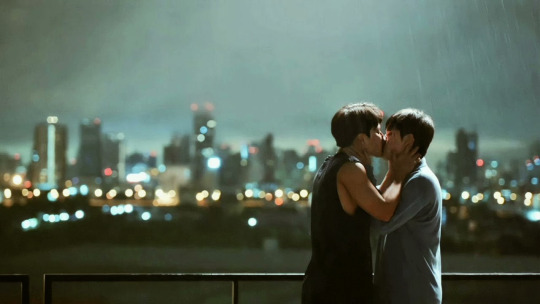
Rooftops belong to the gays now and it should be known. It is a very well known trope used all over genres, but it is has become an very significative one in BLs.
image sources 1 2
Final Toughts
While preparing for this post I decided to research a little about SE Asia’s recent history, as I have been made aware recently that not only thailand is rising in it’s entertaiment production, but Cambodia is rising in the music sphere. All these industries that are sprouting from Southeast Asia, made me wonder why. And my elation when I realized there was a reason why! It all started to get into place in my head.
I have wanted to make this post for a while. In a lot of the conversations we’ve been having in the fandom around shows recently made me realize that a lot of the new fans get into BL without having encountered Asian dramas before or just partially. Lots of the analysis made and the questions posed around BL shows have a partial answer in the context of how the genre came to be and how its intertwined with every other piece of Asian media.
The purpose of this post is to give more detail into how BL is influenced by a lot of the general romance genre, which a lot of the fandom might not know in depth. I hope this clearifies some things for those who search to understand why this or that trope or action happen in a show where it might not make sense, or it might be out of place, or just strange.
As Thailand media is growing, we see how they use what is popular in their favor, while adding a bit of their own personal culture to it. It’s interesting how we can see the kdrama or manga influences. And talking about it and questioning them makes me excited for more.
This will be a series of posts. I have decided to make a post about the general history of BL. Which will be accompanied by another, smaller post where I want to talk about the Yaoi Debates (Yaoi Ronso) and the use of trauma and rape in BLs, as it has been a topic of conversation recently.
A big thank you to @waitmyturtles for her Old GMMTV Challenge, which has promted a lot of conversation about BL and has also made me want to participate in them. I hope this can be complementary to your watches and helps you understand the genre and how it came to be.
#bl tropes#shoujo tropes#bl and it's shoujo grandma#for the fam#and the besties#it got super long but if you read the whole thing I hope you enjoyed it#look forward to the other posts I'm gonna make#bl history
114 notes
·
View notes
Text

#Son Goku#Son Kakarot#DBZ#Dragonball franchise#SSJ 1#Super Saiya-jin#Shonen#1980's anime and manga#Akira Toriyama#toei animation
0 notes
Text
1. The Birth of Astro Boy
It should be noted that this is not the first Astro Boy manga chapter ever written, but was written in 1975 by Tezuka to give the series a more approachable beginning for Asahi Sonorama's edition/compilation of the series.
Note: Throughout this post, I will refer to the whole series as "Astro Boy" but refer to the character as "Atom." If I get mixed up and refer to him as "Astro" once the text is calling him this, we will just have to live with that because I intend on calling him Atom mostly. If this changes later I'll add a new note to whichever post it becomes relevant on.
I'm not making a timeline here, but as "present day" is 2003, the introductory information states that around 1953, robots "existed in great number" but it took many machines to do the work of a single human.
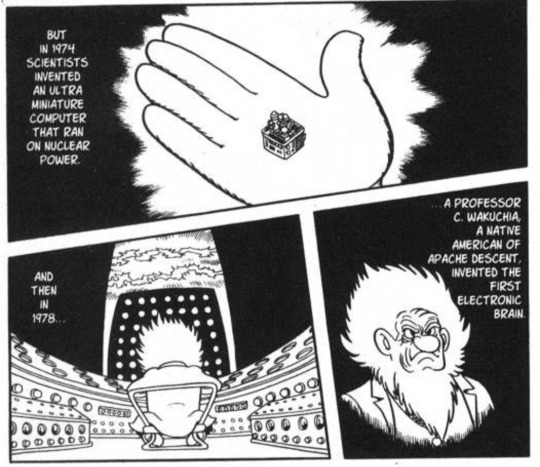
In 1974 our first breakthrough in robotic technology is the "ultra-miniature computer" that runs on nuclear power. This is followed by Professor C. Wakuchia's invention of the first electronic brain 4 years later in 1978. It's also interesting that the manga notes he was of Apache descent. The Japanese professor Sarumane "copied and improved upon the design" and it was used in the first humanoid robot in 1982.

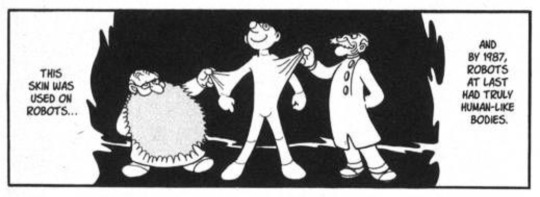
An interesting diversion from the modern-day expected progression of robotics (that being primarily in AI, something not heavily focused on in the original manga and presumably captured entirely by the sentence "First electronic brain") is a heavy focus on that robots were made of metal until Professor James Dalton invented an artificial plastic-based skin in the early 1980's. By 1987, "robots at last had truly human-like bodies."

We start seeing that an important element of robotic development was that around this point, countries became protective of their technologies. Another anti-capitalist anti-militarism W for Tezuka here, and I'll likely end up referencing this later when it comes to international relations in the world of Astro Boy.
While Tezuka didn't heavily stress this, I think it could also be interesting to think about what each country and culture would desire in their robots, and what their own personal goals would be to create a highly advanced robot. Is a truly advanced robot capable of independent decision making, or is it subservient? In what ways is it similar to a human? Can it taste? Cry?
5,000 robots per year in Japan is a "very quick" increase in population, especially in Tokyo. I also think it's notable that "Robots even began studying in schools along with human children" - For a robot like Atom, who is made to be akin to a human, this would make sense, but we see in later Astro Boy media that the idea of robots needing to go to school at all (outside his circumstance) kind of gets lowered quite a bit. I can see why - The benefit of school for a robot who can acquire all the information needed rapidly through either downloads or reading it or having it delivered through audio or video is exclusively social (which is what Atom needs it for, too, although he also receives the information he's learning through school as well instead of through download in the original manga, and as far as I know, the 60s, 80s, and 03 anime) and a robot does not need to learn social skills in the same way a human child does. From an American perspective, around the time the original manga was being created African Americans were actively pushing to remove segregation in schools, and I think this whole movement and reaction to it influenced later Astro Boy media as well, as at its core I believe Astro Boy is about what it means to be human, and therefore, human rights.
From a lore perspective, I agree more with the modern take that robot children would be segregated from human children in schooling and that moving Atom to a human school would be a step that received notable pushback. Robots are (from the belief of many humans) intended to be subservient and do not need the social development of having human friends as equals. If a human had a problem with a robot child, the robot child would be expected to resolve the problem entirely, even if it were not their fault. I also think that the idea of robotic children as they appear in Pluto is extremely interesting (but this isn't the place for that discussion so I'll keep it brief) as they are for the development of the parent robots and the idea of a robotic child ends up limiting the ability of the child robot to develop - If a robotic child could develop, they would no longer be childlike. We don't really see anything about developing child robots into another State in Pluto, so this leads me to believe that a child robot would be kept at a certain level of human development without much of a chance to grow from there (thus making it strange to have a child in the first place - Is the joy of a child not seeing them grow? And we do see some of this in Pluto, that one of their fondest memories with Robita is her walking for the first time, a similar experience to what human parents experience with their own children who do grow and change.) The lack of growth of child robots is also sort of touched on in another original Astro Boy comic, so I'll touch on it later too.

These are the two robotic laws we know so far, and if/when we see more of the robotic (production) laws, I'll be listing them together.
These laws being of robotic production are interesting - If a robot does not prioritize human happiness over their own, this robot is technically against the robotic laws. If a robot injures or kills a human, this obviously results in the robot being disassembled, but it seems like it would also result in their creator being charged as well, as the robot was able to do those things by virtue of the creator not putting in enough safeguards. Again, Pluto plays with this a lot more (robots are capable of harming humans but don't.) (but Pluto doesn't touch on creators of robots also being at fault) but if/when we get to a Pluto analysis, I'll be discussing it then.
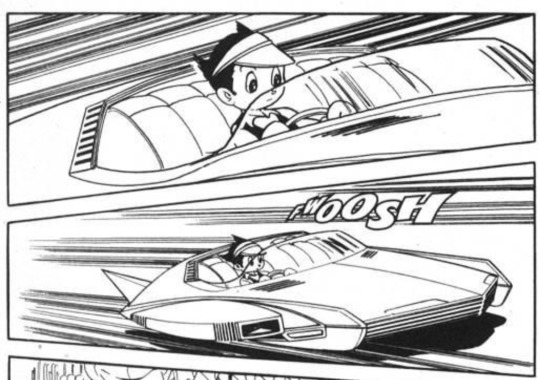
We can see here that human child Tobio is driving a car. This is mostly funny to me - If the robotic car is safe enough for a child to ride in alone, why are his hands on the wheel? Why did it crash at all? Would that crash not be the fault of the robotic car's manufacturer, then? The idea that this accident should be blamed on Tenma (introduced at the very latest in the 1980s anime) is interesting considering this. By 2003 we don't even see him driving a car, he has something more like a bicycle.
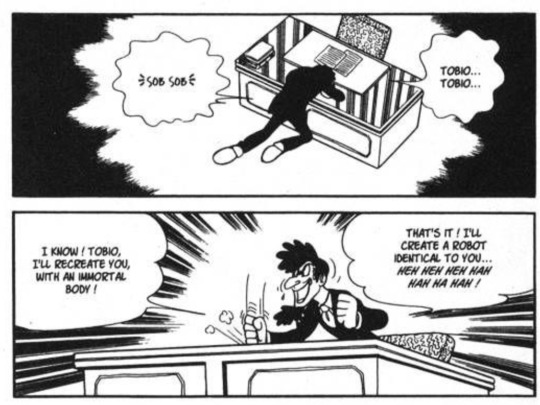
Yea that makes sense. Go ahead and do that man. God I love this series.
Anyway our stress here is on "immortal body" and the goal of having Tobio back, but unable to die. No mention of the weapons and shit he's putting in there but that's probably why.
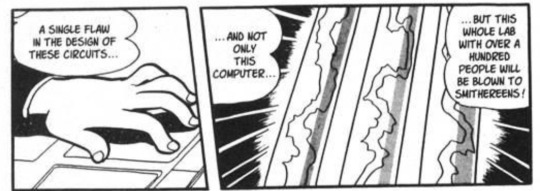
smithereens are basically the most classic thing to blown to.
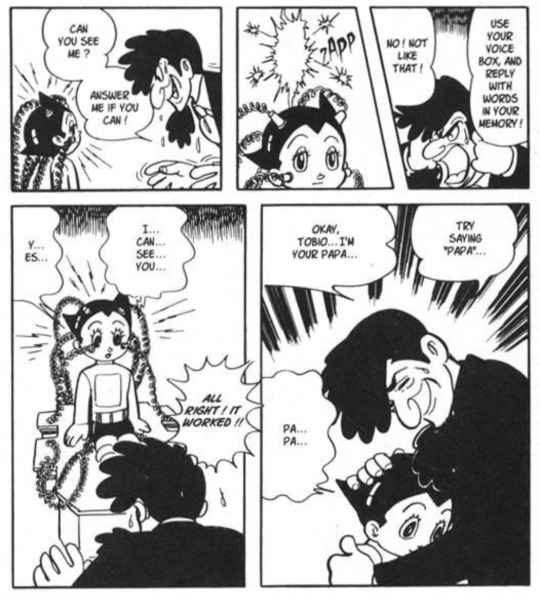
Hooogh I'm normal about it.
First indication that a problem with Atom (for Tenma) is his robotic nature, despite that being something He Did in making him. His natural response is not human enough, and Tenma's response (likely partially for humor) is to yell at him and get angry. I'm also very fond of Atom's facial expressions not being developed yet. That kind of thing is just really special to me, it shows that a lot more work still needs to go into this from both of them to achieve what Tenma really wants - and most of that work is in counteracting the natural way Atom is liable to act and having him emulate humans more closely.
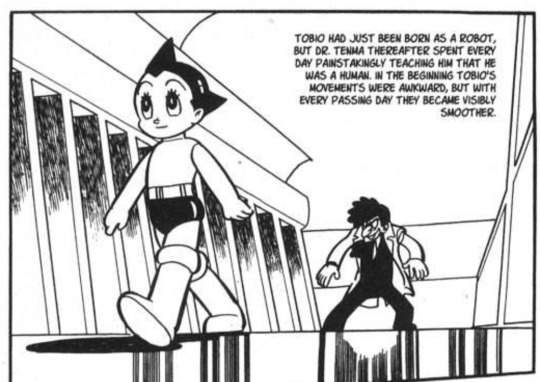
Difficult to say at this point if the original manga has Atom believing initially that he is a human, we do see more play with this in the first episode of the 1980's anime, but it's not really touched on that hard within Astro Boy itself as far as I remember (I suppose the 2009/10 movie does a little, lol, and so does Pluto.). That said, a robot believing themselves to be human is much more notable in Metropolis.
If I were da boss. and I were making my own interpretation of Astro Boy, I do think I would play with this more. The identity crisis element would be really intriguing to me, especially considering that a robot that believes themselves to be human would believe they were above the robotic laws, and the crisis in discovering not only that your identity and self is a lie but also that you are now disallowed from things you previously did not know you were disallowed from and suddenly your own happiness is not allowed to be your priority. I think it would drive some of the robotic rights stuff home a little (although, and I may be wrong, I don't believe the original run of the manga ever really touches on the idea that robots might be entitled to their own happiness over the happiness of humans if the two do not interfere with one another. If I'm wrong we'll see! I have memory issues so some things will be a surprise to me as well even though I reread this series somewhat frequently)
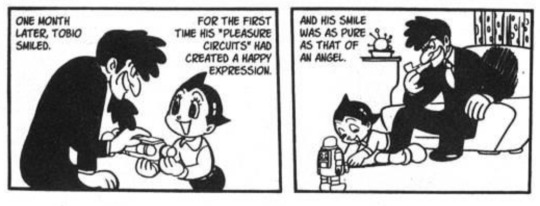
YEAG IT WAS. IT WAS AS PURE AS THAT OF AN ANGEL YOURE SO RIGHT
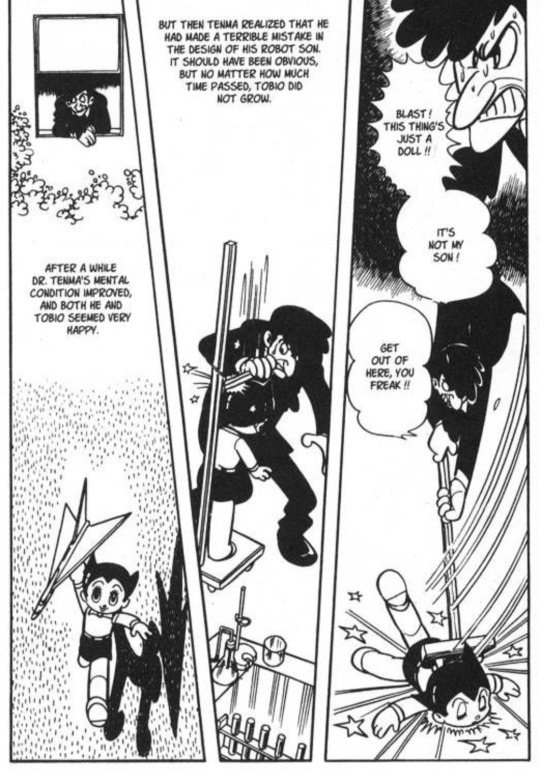
Kind of already started touching on this - But yeah, the unhappiness here (as well as in 1960's anime) comes from him not physically growing, which is funny because You Probably Could Have Made Him Do That In A Number Of Ways But You Shoved A Bunch Of Rockets And Guns In There Instead. I will also touch on one of the ways in a comic where it is made clear to be an option - A robot's brain can be transferred between bodies, so a new body can be made to suit a robot if they prefer, rather than like, surgically changing what is present.
In 1980, the problem is that Tenma believes that the lack of progress on Atom becoming more human is unresolvable.
In 2003, the problem is that Atom is too similar to Tobio, and Tenma does not want Atom to hate him in the same way Tobio did.
I actually do think that the 2009/10 movie was onto something with this because the problem there is that Atom is too similar to Tobio, but Tenma did not know his son and is under the impression he is different. That's a genuinely interesting approach. Atom is doing things Tobio would have done, acting as Tobio would have, and Tenma is like. This is nothing like my son. Because he just didn't know him he never gave him the time. This forces him to reckon with his own grief just the same - He sees the "differences" in Atom and Tobio and is reminded that his son is gone.
In Pluto, the problem is that Atom is too eager to please Tenma and is not similar enough to Tobio. Atom enjoys things and is happy about things, but Tenma remembers that Tobio hated those things. He brings it up, and Atom is like, okay I'll be more like him. But the fact of the matter is that Tenma knows there are fundamental differences now, and this is a different child. He's forced to reckon with his own grief (despite his best efforts to bring Tobio back) in that his son is gone.
The last two are a lot more about grief than they are about inadequacy, and I like that a lot. It's not in any way Atom's fault that he's rejected - It's that the premise of his existence is flawed. A father can't replace their lost child.
The unhappiness coming from Atom not physically growing is notable though, in the same way I mentioned robotic children earlier. They can't grow, that's an important part of who they are. They are created to be children, they can be nothing but children - But a human child is a growing thing, and a human child is defined by the fact that they are changing - they are becoming less childlike every day. A human child is defined by impermanence, and trying to make a child that will not cease to be a child, by death or otherwise, will make a child that is not a child at all.
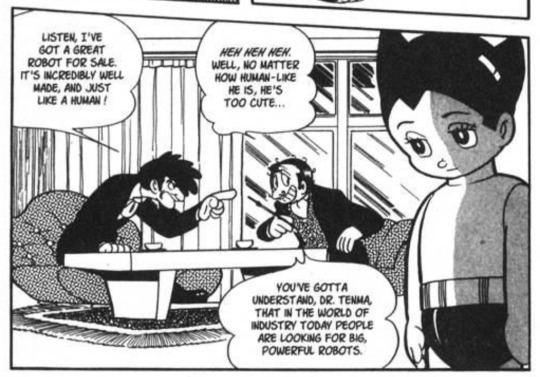
He's so funny for just trying to sell him to any old guy who runs a robot fighting ring after spending like presumably hundreds of millions of Japanese taxpayer dollars on this robot.
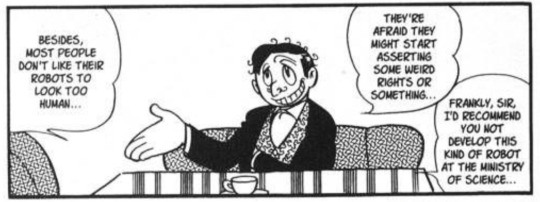
Ahh! Most robots are not created to look human, but Atom is. He's fundamentally representative of a lack of boundary that humans want to ignore. Why would someone want a robot that is not subservient?
To be frankly honest I feel that Pluto missed out on some of this - I like the more explicit approach to hate groups but they don't ever really discuss why they hate robots beyond "they put humans out of a job." I think there's a lot of interesting stuff to be explored here!

Now that he's no longer being used to replace a human child, he's reduced to the same level of robot as others. I may be wrong in remembering this, but I believe in 2003's anime we do see some robots being like, "Atom is a privileged robot and doesn't really represent us - many of us have a built-in purpose, many of us do not have the right to self determination he has. Many of us do not have the humanity he is given, but he is meant to represent us just the same."
The fact that he's had access to these experiences already puts him between robot and human.
Also, "He hadn't learned how to cry yet" is devastating.
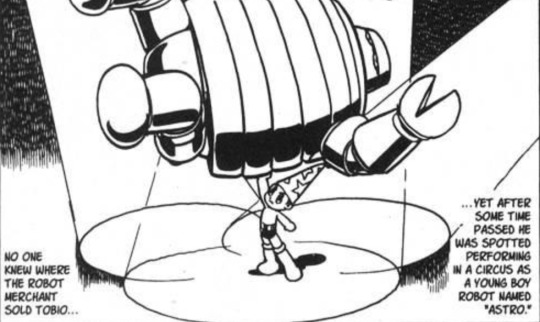
It's interesting that Hamegg is not the circus ringleader here as he is in some later iterations (although, I'm biased, I prefer 2003's approach where he is not sold to a circus at all but rather disposed of and Ochanamizu finds him and brings him back. Sue me.)- So actually, Tenma just sold him to some guy who would sell him elsewhere.
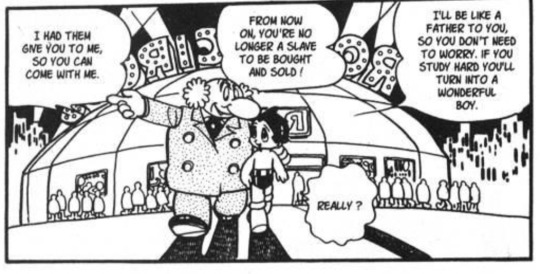
Wow that was easy!

(guy who hates dichotomies between good and bad alert) Nice dichotomy idiot. now what lies outside it.
Thanks for getting through this long analysis of (checks book) 23 pages of content. I should have a little less to say about most other chapters but this one has a lot to chew on.
#astro boy manga analysis#astro boy#mighty atom#tetsuwan atom#Please respond if you feel like it! I'm pretty sure no one at all is going to read this actually.
26 notes
·
View notes